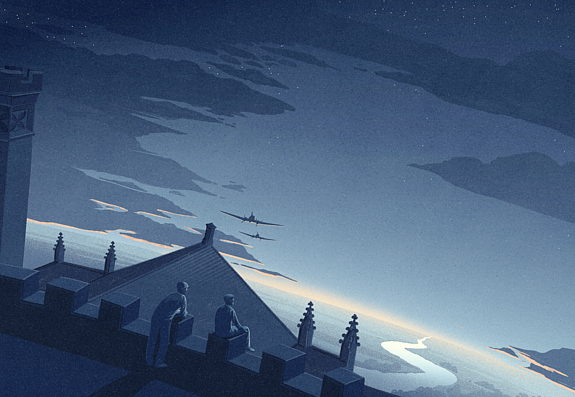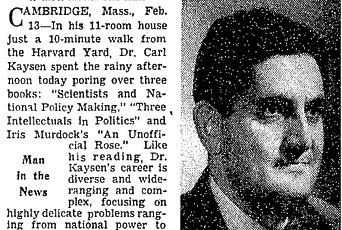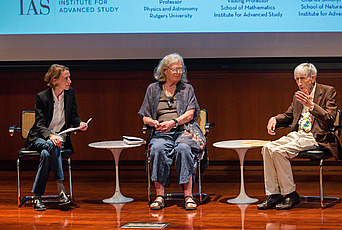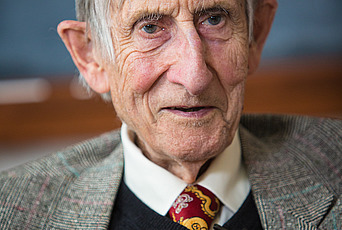“Well, Doc, You’re In”: Freeman Dyson’s Journey through the Universe

"No night is too dark for climbing,” the guidebook said.
That was good news, since the wartime blackout was still in full effect.1 Dyson and Sankey consulted the night climbers’ guidebook before setting out in the darkness to attempt its climbs. First, they conquered the Gateway Column at the Wren Library. Then they managed the Senate House. Finally, they decided to tackle the New Court clock tower at St. John’s.2
The New Court clock tower was profoundly ornate but clockless—just four empty faces stared blankly where the clocks should have been. No one knew exactly why. The climb, according to the guidebook, was fifty feet up from the ground to the roof of the building, followed by another forty feet up the tower. Dyson and Sankey studied Whipplesnaith’s instructions:
To reach the roof … go up the Drain-pipe Chimney, halfway along the outer west wall. Two drain-pipes run from the ground to the battlements in the lee of a buttress set at an angle to the main wall. The right-hand pipe is loose in two places, and should not be trusted too far.3
They shimmied up the left-hand pipe, two improbable silhouettes in the moonlight, as the ground dropped away beneath them. It was easy enough not to be scared—not when a stray bomb could drop out of the sky at any moment anyway. It was a reality Dyson knew too well: he’d stood helpless and watched the student union building, hit by a lost German bomber, burn to the ground.4
The pipe runs up past four windows on the left, at the top and bottom of which a stone foot-hold can be found.5
They kept climbing. There were bright things ahead. Soon Dyson and Sankey would sit down together and write their own guidebook: The Night Climbers of Winchester. It would be their own contribution to the secret rebel club.6
The pipe ends three feet short of the battlements. There is no bowl; it just stops dead. The last few inches pass through a ledge, and so one can grasp the top with confidence. A stretch on to the battlement, and one is safely on the roof.7
Dyson would go on to have a remarkably bright career. So would the rest of the Winchester gang of four—James Lighthill in fluid dynamics, Christopher Longuet-Higgins in theoretical chemistry, Michael Longuet-Higgins in oceanography. They’d all be elected fellows of the Royal Society.
The two buttresses on either side appear to offer the possibility of chimney-ing. However, they diverge too much and one slips.8
The two small figures stood on the rooftop, the tower looming over them. Dyson’s great act of rebellion in the moment was to nurture the seed of an overwhelming optimism—a seed that would blossom into the belief that we live in the most interesting of possible universes, that we can overcome all of it: the limits of our biology, the claustrophobia of our planet, the absoluteness of elsewhere, the heat death of the universe.
One can now reach a ledge to the front and above one’s head. A scramble lands one on a sort of terrace, a yard wide and two yards long.9
They scrambled.
A clockless circle of stone provides the necessary holds. Thus for the first twelve feet.
Some futures would be darker, though—they could sense it. Like Frank Thompson’s. Dyson’s poetic idol at Winchester, Thompson would parachute into German-occupied Yugoslavia, attempting to link up with a resistance movement in Bulgaria. He’d be captured there and, according to newspaper reports, held trial, where spectators would gape in amazement when he refused a translator, not knowing that he was a founding member of the Winchester College Obscure Languages Club. He would answer his accusers in flawless Bulgarian: “I am ready to die for freedom.” And he did.10
The next twelve feet are the most difficult part of the climb. … Pillars rear up at the outside corners and are joined to the Tower by an arch of sloping stone, festooned on the upper side with ornamentations that should not be trusted too far.11
As for Dyson, he’d soon be sent to High Wycombe for Bomber Command, where the same familiar numbers that had danced around his crib would come to mean other things.
For a climber is a man standing on the edge of an abyss.12
Dyson and Sankey perched on the edge. Just two years from now, Sankey would be killed in the battle of Arnhem.13
From now on it is merely a wriggle to get on to the arch, and the rest of the way is practically a stone ladder to the pinnacle.14
They clung to the crowning spire, triumphant, because what they understood implicitly was what Dyson would someday try to tell the Oersted crowd: that this was their education. The books. The secret club. Each other. The Trinity College clock rang out, exultant in the dutiful dark, bells to count the final moments of a childhood. In a minute they’d start the climb back down. For now, they listened to the chimes, and Dyson thought: what a beautiful sound.
Excerpted from “Well, Doc, You’re In” Freeman Dyson’s Journey through the Universe edited by David Kaiser. Reprinted with permission from the MIT Press, Copyright 2023.
- Whipplesnaith, The Night Climbers of Cambridge (Cambridge: Oleander Press, 2007 [1937]), 19.
- Williams, “Cambridge Night Climbing History.”
- Whipplesnaith, Night Climbers, 97.
- Dyson, Maker of Patterns, 23.
- Whipplesnaith, Night Climbers, 97.
- Williams, “Cambridge Night Climbing History.”
- Whipplesnaith, Night Climbers, 97.
- Whipplesnaith, Night Climbers, 101.
- Whipplesnaith, Night Climbers, 101.
- Dyson, Disturbing the Universe, 38.
- Whipplesnaith, Night Climbers, 101.
- Whipplesnaith, Night Climbers, 221.
- Neuenschwander, Dear Professor Dyson, 201.
- Whipplesnaith, Night Climbers, 103.


